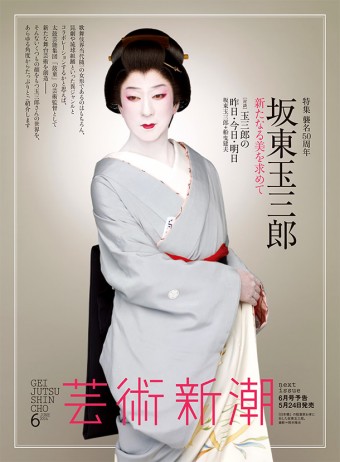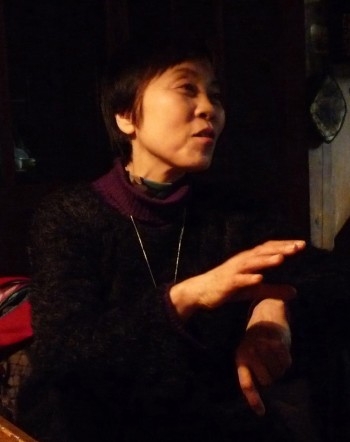Articles & Interviews
News: Article in Magazine “Geijutsu Shincho”
Article featuring Tamasaburo Bando & Kodo in Magazine “Geijutsu Shincho”
An article featuring our artistic director Tamasaburo Bando and Kodo is featured in the June 2014 issue of “Geijutsu Shincho” (Shinchosha Publishing), coming out on May 24. It is full of pictures and stories about the “Kodo One Earth Tour: Mystery” production. We hope you’ll take a look.
Shinchosha Publishing Website|http://www.shinchosha.co.jp/geishin/ (in Japanese)
“From ‘Amaterasu’ to ‘Mystery’: Part 4″ by journalist Sachiko Tamashige
From “Amaterasu” to “Mystery”: Part 4
Article by journalist Sachiko Tamashige
“Mystery” directed by Tamasaburo Bando
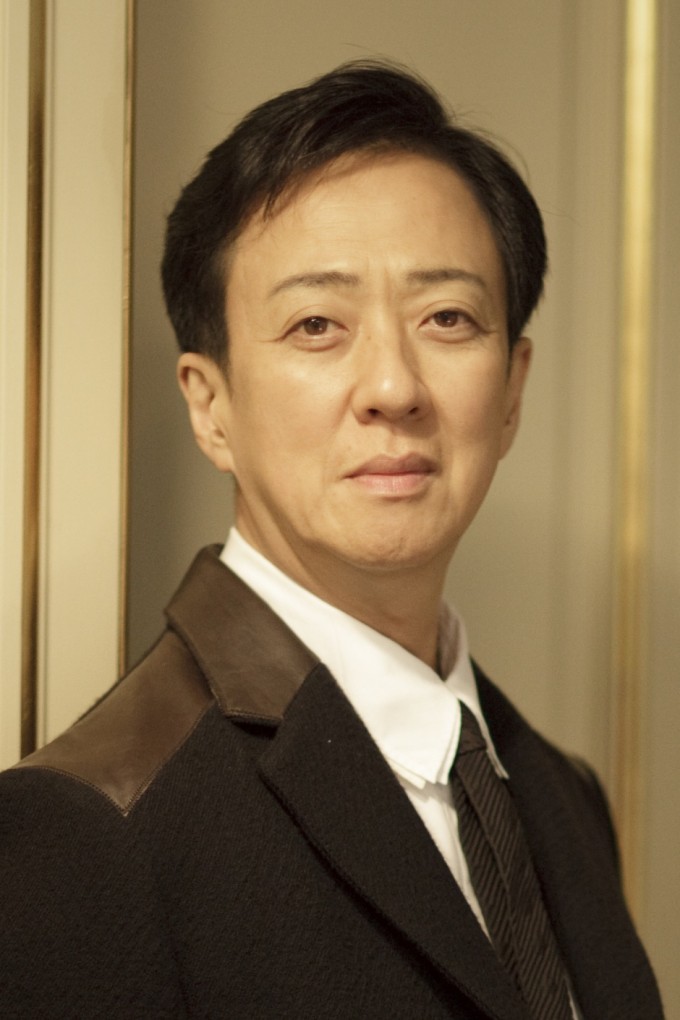
Tamasaburo Bando,
Artistic Director
The audience may wonder what kind of idea lies behind the production of “Mystery.” To address this, Tamasaburo Bando wrote the following note prior to the opening:
“It’s hard to put into words, but I’m aiming to create a world of mystery. Across Japan, the folk arts have been handed down for countless generations. There’s a sacredness there, an air of mystery within each prayer. The drums express this, and I would like for the audience to feel it, too. I hope theatergoers will experience the same sort of otherworldly splendor that you sense in temples, shrines, and moments of discovery in the forest. I also want people to enjoy darkness: the beauty of something you come across lit by candlelight, a sense that is both vague and marvelous. Peel back the layers surrounding mystery and you find fear, humor, charm, and other varied and significant qualities. In the “Serpent Dances” that have come down from old, the defeated serpent is endowed with a surprising level of sacredness. In this performance, many things will emerge from out of the darkness. While it’s essentially a drum concert, playing as only drums can play, we’ve added plenty of visual interest. A moment of wonder means nothing unless you are actually present to experience it. Religious rituals as well as the arts have been refined over centuries, using inspiration from those who came before us. In this drumming performance, I hope that the audience will enjoy to the fullest that magical sense of space and time.”

“Mystery” introduces new theatrical elements and acting parts to the Kodo stage
Just before the opening, I asked the artistic director Tamasaburo the following question: “What is ‘Mystery’ all about ?”
“From ‘Amaterasu’ to ‘Mystery’: Part 3″ by journalist Sachiko Tamashige
From “Amaterasu” to “Mystery”: Part 3
Article by journalist Sachiko Tamashige
Iwami Kagura: Feeling the Heat and Beat in Shimane Prefecture
Yosuke Kusa admires Taizo Kobayashi, his teacher of Iwami Kagura (Iwami: a region, the west part of Shimane Prefecture/ Kagura: dance and music for the kami, or deities): “Taizo looks so cool when he claps his hands to pray for deities in front of the household Shinto altar. Even his everyday routines show his integrity, which is also reflected in his Kagura performance. Kagura is not just about dancing — it is also the way a performer lives their life.” Yosuke met Taizo at the Kyoto University of Art and Design when Taizo ran an Iwami Kagura workshop. Around ten years ago, he started visiting Taizo in his hometown of Yunotsu, Shimane Prefecture.
Taizo’s primary job is making masks for Iwami Kagura. In September of 2013, two cast members of Jamai — Yosuke and Shogo Komatsuzaki — spent two weeks at Taizo’s studio to learn the serpent dance, as well as experience life with the local people. Yosuke and Shogo tried to get to the heart of the Kagura by visiting local shrines, going for runs in the surrounding nature and exchanging ideas and music techniques through sessions with members of a local group of Iwami Kagura. “The local people live with the deities by practicing rituals to either purify themselves or show their gratitude,” Yosuke added, “Iwami Kagura is nourished and enlivened by the way the locals live their lives, and it has been handed down from their ancestors to future generations. Iwami Kagura is also a way for adults to teach good behavior and adherence to the social code to their children. I would like to learn not only the forms and techniques but also its spirit, which links our lives with our direct experience on stage.”

Mr. Kobayashi makes masks at the Kobayashi Workshop.
An array of Kagura masks await their chance to spring into action.
“From ‘Amaterasu’ to ‘Mystery’: Part 2″ by journalist Sachiko Tamashige
From “Amaterasu” to “Mystery”: Part 2
Article by journalist Sachiko Tamashige
Behind the Scenes of “Mystery”
Jamai — the “Serpent Dance” — is derived from Orochi, known as “the Great Serpent Dance” from Iwami Kagura (Iwami: a region, the west part of Shimane Prefecture/ Kagura: dance and music for the kami, or deities).The Kodo cast members of Jamai absorbed the skill and spirit of this traditional folk dance by learning from local performers while in Shimane as artists in residence. Iwami is the name of this area in the western part of Shimane Prefecture. Iwami is famous for its historical site, Iwami Ginzan, the largest silver mine in Japan, a world heritage site. Kagura was originally performed to summon kami (deities) during traditional rituals of worship in shrines and other sacred places. Japanese traditional music, dance and festival culture has its roots in these ancient rituals. Taiko, or the Japanese traditional drum, was once regarded as a sacred instrument because of its magical power to conjure up the deities for tasks such as bringing rain to a region in need.

The Kodo cast members of Jamai absorbed the skill and spirit of this traditional folk dance by learning from local performers while in Shimane as artists in residence.
“From ‘Amaterasu’ to ‘Mystery’: Part 1″ by journalist Sachiko Tamashige
From “Amaterasu” to “Mystery”: Part 1
Article by journalist Sachiko Tamashige
Guided by the Mysterious Power of the Serpent
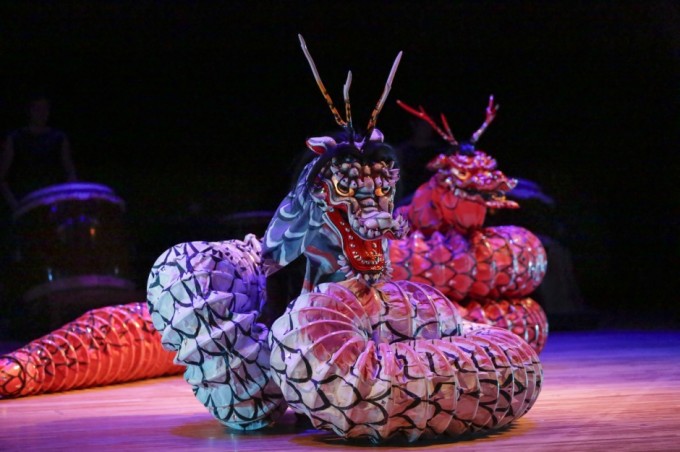
Jamai
Aside from the dim outline of a mountain, the stage is shrouded in darkness. Look closely, and you may catch a glimpse of something undulating in the distance, then out of the black they appear: three giant snakes, entangled with each other. As they gradually reveal themselves, it becomes clear that a spectacular and ominous world awaits. Three snakes wriggle free from each other, their scales glinting in the dim light. The sound of the taiko takes on the cadence of a heartbeat as an eerie melody is played on a Nohkan, the bamboo flute used in Noh and Kabuki theater. Your invitation into a mysterious realm is complete. The snakes return to the darkness while the lights of lanterns float in the air like giant fireflies. Like an ancient lullaby, voices arise, transporting you to forgotten childhood memories.
Where exactly are we? Each of you might ask yourself this question in the darkness. Kodo’s unique sound and spectacle have the ability to transcend the reality around you.
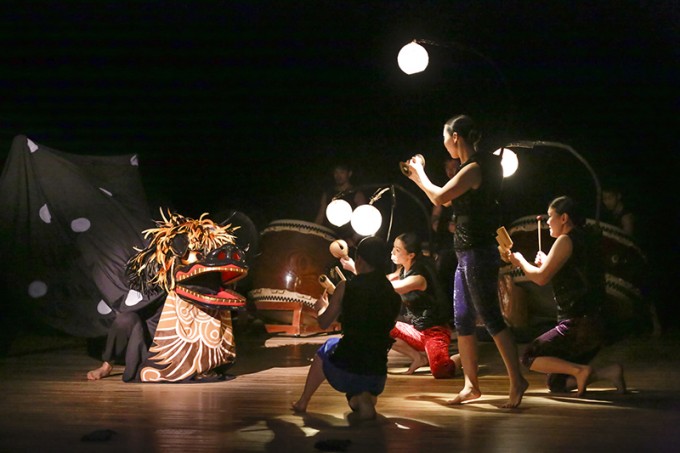
Shishimai
In the autumn of 2013 — the year of the serpent — the brand new production, “Kodo One Earth Tour: Mystery” was revealed with this mesmerizing opening scene. Directed by Tamasaburo Bando and premiering on Sado Island, Kodo’s home and base of operations, Mystery consists of 18 scenes, including ones inspired by traditional folk dances such as Jamai, Namahage and Shishimai, and contains scenes newly created by members of Kodo such as Yomichi and Yuyami, along with pieces from the classic Kodo repertoire.
Eri Uchida and “Mystery”: An Interview by Johnny Wales
“Kodo One Earth Tour 2014: Mystery”
An Interview with Eri Uchida by Johnny Wales
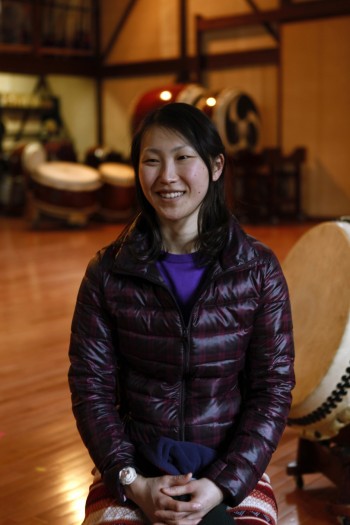
Eri Uchida, Kodo Rehearsal Hall
Eri Uchida was born in Aichi Prefecture in central Japan and is in her sixth year with Kodo. She specializes in taiko but also sings, plays shinobue (bamboo flute) and dances. Here she discusses with Johnny Wales Kodo’s newest production “Mystery” and working with Tamasaburo Bando.
Our new main stage performance is called “Kodo One Earth Tour: Mystery.” It is directed by Tamasaburo Bando. The pieces were written by Kodo members and are almost all new. For me, the principal difference between his first One Earth Tour production “Legend” and the new Mystery is that in Mystery the women are featured more than ever before. In traditional Kodo performances the programme usually builds up to Yataibayashi and O-daiko so the audience leaves the theatre with a lasting impression of the male performers. I think this performance leaves an equally feminine impression. In the early stages of production we worked out a lot of the business for ourselves. At first we thought, ‘Is this going to work on stage?’ I think there is more theatricality in this performance than usual.
I have two pieces in Mystery, Harewataru (meaning “clearing skies”) which is a piece with mainly flute and taiko, and opening up the second act is a piece I composed called Chit Chat. I wanted to express the feeling of girls just having a good chin wag, so the curtain opens to a scene of the women playing and laughing together.
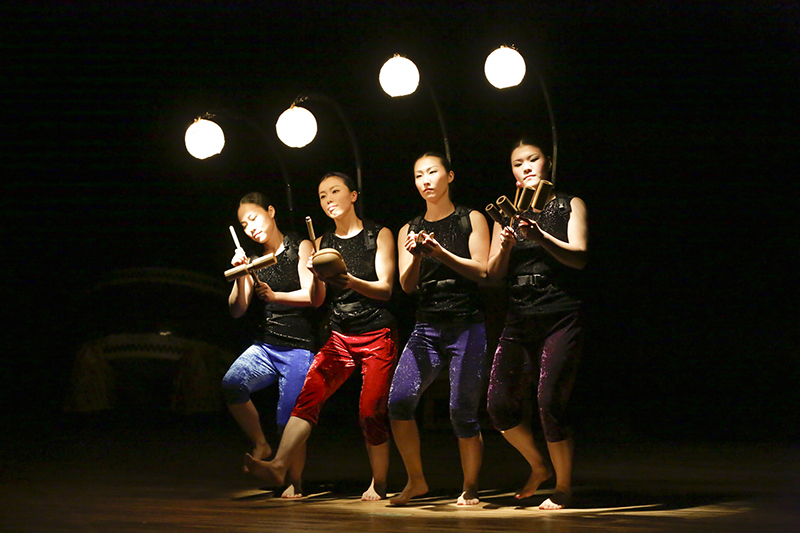
Chit Chat
(From left: Maya Minowa, Mariko Omi, Eri Uchida, Akiko Ando)
About a year ago Tamasaburo asked us all to submit ideas and compositions for consideration on the theme of ‘mystery’. I had never composed anything before but submitted some pieces anyway and what do you know? They made the cut! It has really made me want to compose more in the future. I discovered that in order to create something that expresses yourself, you don’t have to over think it. However to make something really good I have a lot of studying to do.
CD “Yamazu Megurumo”: An Interview with Yoko Fujimoto by Johnny Wales
CD “Yamazu Megurumo”
An Interview with Yoko Fujimoto by Johnny Wales
On March 3rd Yoko Fujimoto released her 2nd solo album ‘Yamazu Megurumo’ (Circle of Life) with Otodaiku. You can order her CD at the Kodo Online Store.
The seed for this project was when my mother in Tokyo became ill and I wondered what I could best do for her living so far away. Well, for me, that is singing. So that’s how it began, a private thing for mum.
I began to think about how life is one long continuous line from time immemorial to now. And relationships – just when you think one might be over – What?! It’s started up again! The ties that bind are re-tied. I wanted to express in song how extraordinary a thing life is, how it renews itself, carrying on in a never-ending cycle. I will be happy if – in some small way – these songs serve as a comfort and encouragement to people who hear them. Incidentally, mum is much better now.
I saw a wonderful Italian movie, “L’uomo che verrà” (The Man Who Will Come) in which an 8 year old girl and her newborn brother are left alone in a mountain village in Italy during the war. Her other little brother had died in her arms the year before and from that shock she lost her ability to speak. She resolves to do anything and everything she can to protect him. The movie ends with her finding her voice by breaking into a lullaby to her little brother. Even this tiny, seemingly powerless girl found the strength to carry on the line of life. And so it has ever been. This power that has allowed our race to continue to this day. So I wrote a poem about that. Then I learned the traditional Italian lullaby from the movie and began singing it.
As it happened last year was a very confusing time for me, there were so many changes in my life. I was even thinking about quitting singing for good. A close friend said to me, ‘Stop being confused! You have been blessed with the chance to sing with Kodo for 30 years, stop whining!’ She opened my eyes. I showed her my poem. She said, ‘You should do this! Make this into a song!’. That friend who helped is an abstract painter. I wanted to use one of her paintings on the CD cover. She asked me the name of the CD project and I told her, ‘Circle of Life’ and she said, ‘Wait there!’ and disappeared into another room. She reappeared with a smallish painting and said ‘This is my favourite painting! And its called ‘Circle of Life’ (Meguru Inochi). That settled it.
I first recorded the songs with no accompaniment and sent them to Shunsuke Kimura who laid down the accompaniment. He played fue (bamboo flute) and some Japanese percussion, and added other musicians on Tsugaru shamisen, wadaiko, 13 and 17 string kotos, world music percussion and violin. ▶ read more




